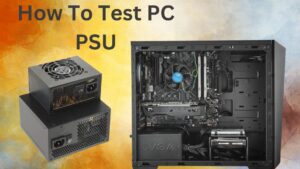How to Check PSU Health and Ensure System Stability |
Your computer’s power supply unit (PSU) is often overlooked but plays a crucial role in the overall stability and performance of your system. Think of it as the heart of your computer, supplying power to every component and ensuring smooth operation. In this article, we’ll explore the importance of maintaining PSU health and provide a comprehensive guide on how to check PSU health to ensure your system stays stable and reliable. Whether you’re a seasoned PC enthusiast or a beginner, understanding and monitoring your PSU’s health is essential for the longevity of your system. Let’s dive in and learn how to keep your computer running smoothly by taking care of its power source.
Understanding PSU Health:
PSU health refers to the condition and performance of a Power Supply Unit (PSU) in a computer or device. A healthy PSU efficiently converts electrical power, maintains stable voltage, and provides consistent power to components. Key factors affecting PSU health include power efficiency, cooling performance, and the condition of internal components like capacitors. Over time, a PSU can degrade, leading to instability, overheating, or even failure. Monitoring PSU health is crucial for system stability, as poor PSU health can result in crashes, data loss, or hardware damage. Regular checks and maintenance ensure the PSU’s optimal performance. To understand PSU health checks, it’s essential to grasp the roles of its key components and the importance of regular checks.
Explanation of PSU Components and Their Functions:
- Capacitors: Capacitors store and release electrical energy to help stabilize voltage levels. They play a crucial role in smoothing out fluctuations in power delivery.
- Transformers: Transformers are responsible for converting the incoming AC voltage to the required output voltage levels, such as +12V, +5V, and +3.3V, which different components in your system require.
- Voltage Regulators: Voltage regulators ensure that the output voltage remains stable, even under varying loads. They help prevent voltage spikes or drops that can damage components.
Understanding how these components work together allows you to appreciate the complexity of the PSU and the importance of keeping them in good condition.
Importance of Regular PSU Health Check:
Regular PSU health checks are essential for several reasons:
- Preventing System Failures: A failing PSU can lead to system instability, crashes, and even hardware damage. By regularly checking your PSU’s health, you can identify potential issues early and take corrective action before they escalate.
- Ensuring Stable Power Delivery: A healthy PSU provides stable and reliable power to your components, ensuring optimal performance and longevity. Regular checks help maintain consistent voltage levels and prevent power-related issues.
- Maximizing System Lifespan: Your PSU’s health directly impacts the lifespan of your entire system. By monitoring and maintaining your PSU health check, you can prolong the life of your components and avoid costly replacements.
Signs of PSU Problems:
Your power supply unit (PSU) is a critical component of your computer system, and when it starts to fail, it can lead to a host of issues. Recognizing the signs of PSU problems early on is crucial for preventing system instability and potential hardware damage. Here are some common symptoms indicating PSU issues and why it’s essential to recognize these warning signs early:
Common Symptoms Indicating PSU Issues:
- Random System Shutdowns: If your computer shuts down unexpectedly without any apparent cause, it could be a sign of a failing PSU. Sudden loss of power can occur when the PSU fails to deliver adequate power to the components.
- Unusual Noises: Strange noises emanating from your PSU, such as buzzing, whining, or clicking sounds, are often indicators of underlying issues. These noises may suggest failing components or fan malfunctions within the PSU.
- Voltage Fluctuations: Voltage fluctuations can manifest as flickering lights, monitor flickering, or irregular behavior from connected devices. These fluctuations may occur due to unstable power delivery from a failing PSU.
- Burning Smell: A burning smell coming from your computer, particularly near the PSU, is a severe warning sign of overheating or electrical issues. It’s essential to address this issue immediately to prevent potential fires or further damage.
- Failure to Power On: If your computer fails to power on altogether, the PSU could be the culprit. However, it’s essential to rule out other potential causes, such as faulty power cords or motherboard issues, before concluding that the PSU is at fault.
Importance of Recognizing Warning Signs Early:
Recognizing warning signs of PSU problems early on is crucial for several reasons:
- Prevent System Instability: Identifying PSU issues early allows you to take corrective action before they escalate into full-blown system instability. Addressing these issues promptly can prevent sudden shutdowns or crashes, ensuring smooth system operation.
- Avoid Hardware Damage: A failing PSU can deliver inconsistent power to your components, potentially causing damage over time. By recognizing warning signs early, you can minimize the risk of hardware damage and avoid costly repairs or replacements.
- Ensure Data Integrity: Sudden power loss due to PSU failure can result in data loss or corruption, particularly if you’re in the middle of a task. Recognizing warning signs early allows you to back up your data and mitigate the risk of data loss.
Basic Tools for PSU Health Checks:
Before delving into the process of checking your PSU health check, it’s essential to familiarize yourself with the basic tools required for the task. Two primary tools commonly used for PSU health checks are the multimeter and the PSU tester. Let’s explore each tool’s function and usage in detail:
1. Multimeter:
A multimeter is a versatile electronic tool used to measure various electrical parameters, including voltage, current, and resistance. It consists of a display screen, selection dial, and probes for making electrical connections. Here’s how to use a multimeter for PSU health checks:
- Function: The multimeter allows you to measure the voltage output of different PSU rails, such as +12V, +5V, and +3.3V, to ensure they are within acceptable ranges.
- Usage: Set the multimeter to the voltage (V) measurement mode and connect the probes to the corresponding PSU connectors. Turn on the computer and observe the voltage readings displayed on the multimeter. Compare the readings to the specified voltage ranges to determine if the PSU is functioning correctly.
2. PSU Tester:
A PSU tester is a specialized tool designed specifically for testing power supply units. It typically consists of a display screen, connectors for PSU cables, and indicator lights to display test results. Here’s how to use a PSU tester for PSU health checks:
- Function: The PSU tester provides a quick and easy way to assess the functionality of a PSU by simulating load conditions and measuring voltage outputs.
- Usage: Connect the PSU tester to the corresponding PSU cables, ensuring proper alignment of connectors. Turn on the PSU and observe the indicator lights on the tester. Green lights indicate that the PSU is functioning correctly, while red lights may indicate potential issues with voltage output or power delivery.
Other Tools:
In addition to the multimeter and PSU tester, some other tools and accessories may be useful for PSU health checks, including:
- Spare PSU Cables: Having spare PSU cables on hand can be helpful for testing purposes, especially if you need to replace damaged or faulty cables during the testing process.
- Anti-static wrist strap: To prevent electrostatic discharge (ESD) damage to sensitive components, wearing an anti-static wrist strap while handling electronic equipment is recommended.
By equipping yourself with these basic tools and accessories, you’ll be well-prepared to perform comprehensive checks on your PSU and ensure the health and reliability of your computer system.
Testing PSU Voltage Output:
Testing the voltage output of your power supply unit (PSU) is a critical step in assessing its health and ensuring stable power delivery to your computer components. We’ll provide a step-by-step guide on how to test PSU voltage output using a multimeter, along with the interpretation of voltage readings and acceptable ranges.
Step-by-Step Guide:
- Prepare Your Multimeter: Set your multimeter to the voltage (V) measurement mode. Ensure that the range selected is appropriate for the voltage you expect to measure (e.g., DC voltage for PSU testing).
- Locate PSU Connectors: Identify the main PSU connectors where you’ll be testing the voltage output. These connectors typically include the 24-pin ATX connector, 4/8-pin CPU connector, and SATA/Molex connectors for peripheral devices.
- Connect Multimeter Probes: Insert the black probe (negative) into the COM (common) port and the red probe (positive) into the VΩmA (voltage, ohms, milliamp) port on your multimeter.
- Test PSU Rails: Connect the multimeter probes to the appropriate pins on the PSU connectors. For example, to test the +12V rail, connect the red probe to the +12V pin and the black probe to a ground pin. Repeat this process for the +5V and +3.3V rails.
- Power On Your Computer: Turn on your computer and allow it to boot into the operating system. Monitor the voltage readings displayed on the multimeter. Ensure that the readings stabilize and remain within acceptable ranges.
- Record Voltage Readings: Take note of the voltage readings for each rail (e.g., +12V, +5V, +3.3V). Write down the values or take a screenshot for reference.
- Interpret Voltage Readings: Compare the voltage readings to the specified voltage ranges for your PSU. Acceptable voltage ranges may vary depending on your PSU model and specifications. However, typical voltage ranges for a standard ATX PSU are as follows:
- +12V Rail: 11.4V to 12.6V
- +5V Rail: 4.75V to 5.25V
- +3.3V Rail: 3.135V to 3.465V
- Evaluate Results: If the voltage readings fall within the acceptable ranges, your PSU is likely functioning correctly. However, if any readings are outside the specified ranges, it may indicate potential issues with the PSU’s voltage regulation or power delivery.
- Repeat Testing (Optional): For thorough assessment, you can repeat the testing process multiple times to ensure consistency and accuracy of the voltage readings.
Interpretation of Voltage Readings and Acceptable Ranges:
- +12V Rail: The +12V rail provides power to components such as the CPU, GPU, and hard drives. Voltage readings within the range of 11.4V to 12.6V are considered acceptable.
- +5V Rail: The +5V rail supplies power to components such as USB ports, RAM modules, and the chipset. Voltage readings should fall between 4.75V to 5.25V.
- +3.3V Rail: The +3.3V rail powers components like SSDs, PCIe slots, and some RAM modules. Acceptable voltage readings range from 3.135V to 3.465V.
It’s important to note that while minor fluctuations in voltage readings are normal, significant deviations from the specified ranges may indicate potential PSU issues. If you encounter voltage readings outside the acceptable ranges, further troubleshooting may be necessary to identify and resolve the underlying problems.
Load Testing the PSU:
Load testing your power supply unit (PSU) is a crucial step in assessing its performance and ensuring it can handle the power demands of your computer components. In this section, we’ll discuss the importance of load testing and provide instructions for conducting a load test, including calculating power consumption.
Importance of Load Testing:
Load testing involves placing a significant workload on the PSU to simulate real-world usage scenarios. This allows you to evaluate the PSU’s ability to deliver stable power under varying loads and identify any potential issues, such as voltage fluctuations or overheating. Here are some reasons why load testing is essential:
- Assess PSU Stability: Load testing helps determine if the PSU can maintain stable voltage outputs under heavy loads. This is crucial for preventing system instability, crashes, or damage to components.
- Verify PSU Capacity: By determining the maximum power consumption of your components and conducting a load test, you can ensure that the PSU has sufficient capacity to handle the power requirements of your system.
- Identify Overloading Issues: Load testing allows you to detect any overloading issues, where the PSU may struggle to provide adequate power to all components simultaneously. This helps prevent potential damage to the PSU or other components.
Instructions for Conducting a Load Test:
- Determine Component Power Consumption: Start by identifying the power consumption of each component in your system, including the CPU, GPU, RAM, storage drives, and peripherals. You can usually find this information in the component specifications or by using online calculators.
- Calculate Total Power Consumption: Add up the power consumption values of all components to determine the total power draw of your system under typical usage conditions. This will give you an estimate of the maximum load that the PSU may encounter.
- Select Load Testing Method: There are two primary methods for conducting a load test:
- Hardware Load Test: Connect components directly to the PSU and run stress tests or benchmarking software to place a heavy load on the system. Monitor voltage outputs and temperatures during testing to ensure stability.
- PSU Load Tester: Use a dedicated PSU load tester, which simulates various load conditions without requiring components to be connected. This method provides a quick and convenient way to assess PSU performance.
- Monitor PSU Performance: During the load test, monitor the PSU’s voltage outputs using a multimeter or monitoring software. Ensure that the voltage readings remain within acceptable ranges specified by the PSU manufacturer.
- Evaluate Test Results: After completing the load test, evaluate the PSU’s performance and stability. If voltage readings fluctuate significantly or fall outside acceptable ranges, it may indicate potential issues with the PSU’s regulation or capacity.
By following these instructions and conducting a thorough load test, you can assess your PSU’s performance and ensure it can deliver stable power to your system under varying loads. This proactive approach helps prevent potential issues and ensures the reliability and longevity of your computer system.
Checking PSU Fan Operation and Cooling:
The cooling system of your power supply unit (PSU) is critical for maintaining system stability and preventing overheating-related issues. In this section, we’ll discuss the significance of PSU cooling and provide methods for inspecting PSU fan operation and cleaning.
Significance of PSU Cooling for System Stability:
- Heat Dissipation: The PSU generates heat as it converts AC power from the wall outlet to DC power for your computer components. Proper cooling ensures efficient heat dissipation, preventing the PSU from overheating and potentially damaging internal components.
- System Reliability: Overheating can lead to decreased performance, system instability, and premature component failure. Adequate PSU cooling helps maintain stable operation and prolongs the lifespan of your computer system.
- Safety Concerns: Excessive heat buildup within the PSU can pose safety risks, including the potential for fires or electrical malfunctions. Proper cooling mitigates these risks and ensures the safe operation of your system.
Methods for Inspecting PSU Fan Operation and Cleaning:
- Visual Inspection: Start by visually inspecting the PSU fan for any signs of dust buildup, obstructions, or damage. Use a flashlight if necessary to get a clear view of the fan blades and surrounding components.
- Listen for Unusual Noises: Turn on your computer and listen for any unusual noises coming from the PSU fan. Grinding, rattling, or clicking sounds may indicate a malfunctioning fan that requires attention.
- Check Airflow: Place your hand near the PSU fan vent while the computer is running to feel for airflow. A lack of airflow or weak airflow may suggest a problem with the fan or ventilation system.
- Clean the PSU Fan: If you notice dust buildup on the PSU fan or surrounding components, it’s essential to clean them to ensure optimal cooling performance. Use compressed air or a soft brush to gently remove dust and debris from the fan blades and ventilation openings.
- Inspect Ventilation: Ensure that the PSU fan vent and surrounding ventilation openings are not blocked by cables, dust, or other obstructions. Proper airflow is essential for effective cooling, so it’s essential to maintain clear pathways for air circulation.
- Monitor Temperature: Use monitoring software or BIOS settings to monitor the PSU temperature periodically. High temperatures may indicate inadequate cooling or other issues that require attention.
By inspecting PSU fan operation and cleaning regularly, you can ensure proper cooling performance and prevent overheating-related issues. This proactive approach helps maintain system stability, reliability, and safety, ensuring smooth operation of your computer system for years to come.
Advanced PSU Diagnostics:
While basic PSU health check using multimeters and load testing are effective for most users, advanced diagnostic techniques provide deeper insights into PSU performance and reliability. In this section, we’ll provide an overview of advanced diagnostic techniques and recommendations for specialized testing equipment and software tools.
Overview of Advanced Diagnostic Techniques:
- PSU Ripple Voltage Testing: Ripple voltage refers to small fluctuations in the DC output voltage of the PSU, typically caused by the switching action of internal components. High ripple voltage can indicate poor voltage regulation and may lead to instability or damage to sensitive components. Advanced diagnostic tools, such as oscilloscopes, can measure ripple voltage accurately and help assess PSU performance.
- Efficiency Testing: PSU efficiency refers to the ratio of output power to input power and is a measure of how effectively the PSU converts AC power from the wall outlet into DC power for your components. Higher efficiency ratings indicate less power loss and better performance. Specialized testing equipment, such as power analyzers, can measure PSU efficiency under various load conditions and provide valuable insights into overall performance.
- Transient Response Testing: Transient response refers to the PSU’s ability to respond quickly and accurately to changes in load or input voltage. Poor transient response can result in voltage spikes or dips, leading to system instability or damage. Advanced diagnostic tools, such as transient response testers, can simulate load changes and measure the PSU’s response time and stability.
Recommendations for Specialized Testing Equipment and Software Tools:
- Oscilloscope: An oscilloscope is a versatile tool used for measuring and analyzing electrical signals over time. It’s invaluable for ripple voltage testing and provides detailed waveform analysis to identify irregularities or abnormalities in PSU output.
- Power Analyzer: A power analyzer is a precision instrument designed for measuring electrical parameters such as voltage, current, power, and energy consumption. It’s ideal for efficiency testing and can provide accurate measurements of PSU efficiency under different load conditions.
- Transient Response Tester: A transient response tester is a specialized tool used to evaluate the PSU’s transient response characteristics. It applies rapid load changes or voltage perturbations to the PSU and measures its response time, overshoot, and settling time to assess stability and performance.
- PSU Diagnostic Software: Several software tools are available for monitoring PSU health and performance in real time. These tools provide data on voltage, temperature, fan speed, and other parameters, allowing users to identify potential issues and track system stability over time.
Preventive Maintenance Tips:
Maintaining the health of your power supply unit (PSU) is essential for ensuring the stability and longevity of your computer system. In this section, we’ll provide practical tips for how to check PSU’s health and prolong its lifespan, emphasizing the importance of regular cleaning, ventilation, and proper PSU selection.
1. Regular Cleaning:
- Dust buildup inside the PSU can obstruct airflow and cause overheating. Periodically clean the PSU and surrounding components using compressed air or a soft brush to remove dust and debris.
- Pay special attention to the PSU fan and ventilation openings, as these areas are prone to accumulating dust. Clean them thoroughly to ensure optimal airflow and cooling performance.
2. Proper Ventilation:
- Ensure adequate ventilation within your computer case to prevent heat buildup around the PSU and other components. Install additional case fans if necessary to improve airflow and circulation.
- Avoid blocking PSU ventilation openings or placing the computer in enclosed spaces with limited airflow, as this can lead to overheating and reduced PSU efficiency.
3. Proper PSU Selection:
- Choose a high-quality PSU from a reputable manufacturer with sufficient wattage and efficiency ratings for your system’s needs. Consider factors such as the number and power requirements of your components when selecting a PSU.
- Invest in a PSU with features such as over-voltage protection, under-voltage protection, and short-circuit protection to safeguard against potential issues and ensure reliable operation.
4. Avoid Overloading:
- Avoid overloading the PSU by connecting too many components or devices beyond its rated capacity. Check the PSU’s specifications and ensure that the total power consumption of your components does not exceed its maximum output.
- Distribute power-hungry components evenly across different PSU rails to balance the load and prevent strain on individual circuits.
5. Monitor PSU Health:
- Use monitoring software or BIOS settings to monitor PSU temperature, fan speed, and voltage outputs regularly. Keep an eye out for any abnormalities or fluctuations, which may indicate potential issues with the PSU.
- Conduct periodic PSU health check using multimeters or specialized testing equipment to assess performance and identify any underlying problems early on.
6. Backup Power Protection:
- Consider investing in an uninterruptible power supply (UPS) to protect your computer system from power surges, fluctuations, and outages. A UPS provides backup power during emergencies and helps prevent damage to sensitive components, including the PSU.
Conclusion: How To Check PSU Health
Regular PSU health checks are essential for ensuring the stability and reliability of your computer system. By proactively monitoring how to check PSU health and following preventive maintenance practices, you can prevent potential issues, maximize system performance, and prolong the lifespan of your components. We encourage readers to incorporate regular PSU health checks into their maintenance routines and to invest in the necessary tools and equipment to perform these checks effectively. By taking proactive measures to care for your PSU, you can enjoy a stable and reliable computer system for years to come.
Remember, a healthy PSU is the foundation of a stable and robust computer system. So don’t wait until problems arise—start performing regular PSU health check today to ensure the continued smooth operation of your system.
Last Updated on 26 January 2025 by Ansa Imran

Haleema is an experienced PC builder who has been building PCs for the last couple of years. He has written several articles on PC components, including power supplies and graphics cards. In his articles, he explains how to check the compatibility of a power supply with a GPU and what things to consider when pairing them.







